Spice fennel has been used as a medicinal and culinary herb since ancient times. The large yellow flower umbels of the strong-growing perennial are a real eye-catcher.
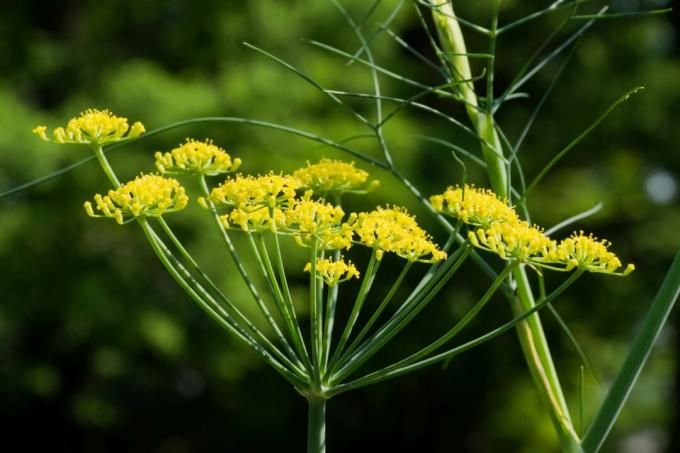
The filigree leaves of the fennel (Foeniculum vulgare var. dulce) give many dishes an aromatic taste. The seeds have long been valued for their healing powers. In this article you will learn everything you need to know about the cultivation, care and use of the medicinal herb.
contents
- Spice fennel: origin and properties
- Growing spice fennel: location and procedure
- Care of sweet fennel
- Harvesting and Use of Spiced Fennel
Spice fennel: origin and properties
The spice fennel or sweet fennel belongs to the umbelliferae family (Apiaceae). The natural range extends from Central Europe to North Africa to West Asia, but nowadays the plant can be found in many places around the world. It is a biennial plant that forms large double umbels with many yellow individual flowers in the second year from July. Between October and November the seeds, which are oblong and crescent-shaped, mature. The leaves are also elongated, thin and multipinnate. Since the individual fennel leaves are not particularly large, the plants form many of them. Depending on the nutrient, water and space available, fennel plants grow between 50 and 150 cm tall. In contrast to the bulbous fennel, the spice fennel does not form a thickened tuber on the ground.
Egyptians, Romans and Greeks have been using fennel as a remedy for over 4000 years. For this purpose, the seeds were boiled as a tea. The filigree leaves can be used as a spice in the kitchen and their taste is reminiscent of aniseed.

The true fennel (Foeniculum vulgare) is divided into three varieties, which differ mainly in terms of appearance and use of the plant:
- fennel (Foeniculum vulgare var. dulce): The seeds of the spice fennel serve as a spice or are prepared as a tea. The leaves can be used as culinary herbs. A special spice fennel variety is Foeniculum vulgare var. dulce ‘Rubrum’, also called bronze fennel. The pinnate leaves are bronze in color and an eye-catcher in any garden.
- fennel (Foeniculum vulgare var. azoricum): This variety is also known as sweet fennel or onion fennel. Here the thickened tuber is eaten.
- Wild Fennel (Foeniculum vulgare var. vulgar): Wild fennel is also called bitter fennel. This is the wild form, which was used as a medicinal plant by the Romans in ancient times.
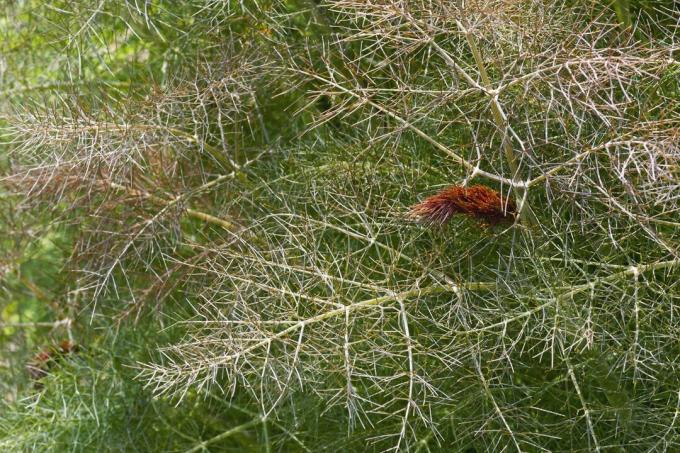
Growing spice fennel: location and procedure
Sweet fennel is a sun-loving perennial that prefers a nutrient-rich and humus-rich soil. If you want to harvest the seeds, you have to wait until late autumn of the second year. The soil should be calcareous and have a neutral to slightly basic pH. Since the young plants are still sensitive and like to be eaten by snails, we recommend growing them on the windowsill from April. From mid-May, however, the seeds can also be sown directly outdoors.
Tip: In order to maintain healthy plants, make sure that the crops rotate in the garden and do not plant sweet fennel after umbellifers. These include, for example, dill, carrots, cumin, parsnips or goutweed.
Sowing and growing spice fennel:
- Sow in pots from April; fill plant pots with potting soil; our Plantura Organic Herb & Seed Soil with its pH value of 6.1 to 6.9, it is ideal for growing young plants; Press the soil firmly into the pots.
- Plant 1 – 2 seeds per pot at a depth of 5 mm and cover with soil.
- water seeds well; then place in a bright place at around 20 – 25 °C; Germination after about a week.
- After germination: move to a place with 15 – 18 °C for healthy plant development; to harden on warm days, put them in the shade for a few hours at first, then for longer periods outdoors.
- From mid-May: plant out outdoors at a distance of 50 cm.
- Water well and provide enough water over the next few days as soon as wilt occurs.
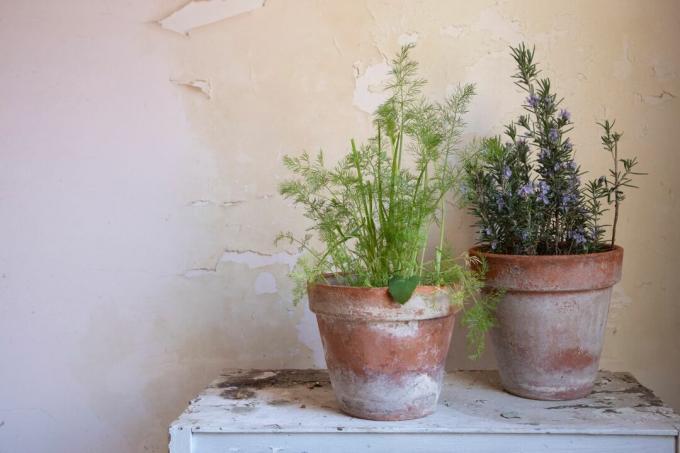
Tip: Spice fennel is also suitable for growing in a bucket. Use a loose soil that has a high water storage capacity. Our Plantura organic tomato & vegetable soil is, for example, nutritious, peat-free and, thanks to the coconut pith it contains, can keep a good supply of water. Place the pot in a sunny spot. Plants need to be watered regularly, especially on hot days.
Spice fennel in mixed culture: Fennel gets along well in the bed with peas, cucumbers, celery, leeks or lamb's lettuce. Avoid tomatoes as direct neighbors.
Care of sweet fennel
The plants require relatively little maintenance. During longer periods of drought, fennel should be watered sufficiently. Weeds should be removed regularly from young plants so that the fennel plants are not in fierce competition for water, light and nutrients. In the spring of the second year, dried shoots can be removed. In nutrient-poor soils, fertilization when planting and in early summer makes sense. A long-term fertilizer like ours is suitable for this Plantura organic tomato fertilizer, which, in addition to fennel, can also be used for many other vegetable crops. The nutrients in the organic fertilizer are released over a period of more than three months and ensure good growth.
Is spice fennel hardy? Young fennel plants and fennel in pots should be protected from frost. Strong outdoor plants, on the other hand, do not need special protection. Most of the shoots die off over the winter, but this is normal. The plant will then sprout again the following year.
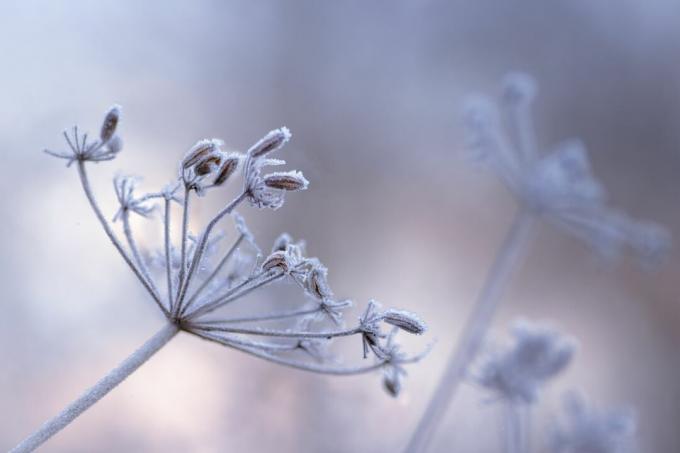
Harvesting and Use of Spiced Fennel
During the summer, the tender leaves can be used as a spice in the kitchen. The taste of the leaves is reminiscent of anise and they are suitable for use in dips, sauces and salads. The seeds are used in naturopathy for digestive problems, respiratory diseases and as a tea during pregnancy. In addition, the seeds are also used in the kitchen as a spice or in bread. The seeds fully mature in the second year between October and November. To harvest the fennel seeds, cut off the whole umbels when the first seeds fall down by themselves. You can tie the umbels into a bouquet and place them over a jar. This is how you catch all the seeds in the container.
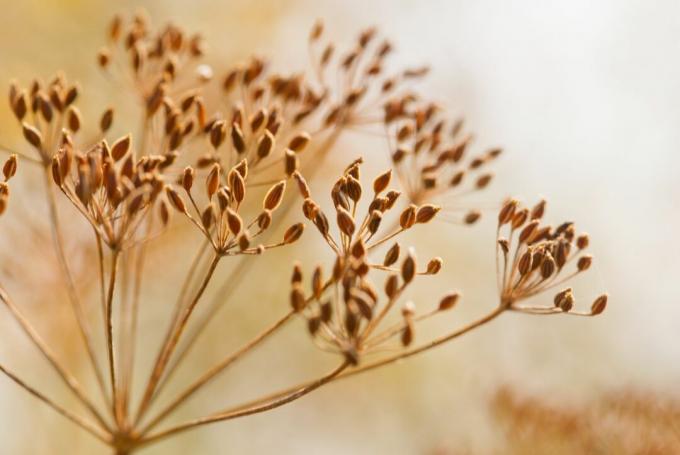
Tip: If you only want to process the leaves, you can regularly remove the flower umbels before they open. As a result, fennel plants can keep in the same place for four to five years.
The bulbous fennel, which is closely related to the spice fennel, is particularly suitable for use in the kitchen. A variety selection and tips for Cultivation, care and harvesting of bulbous fennel see this article.



